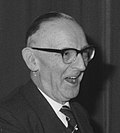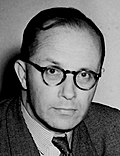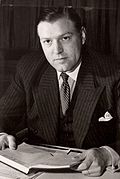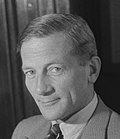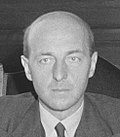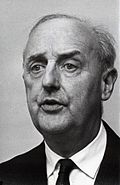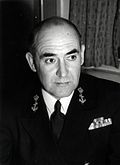Drees–Van Schaik cabinet
Drees–Van Schaik cabinet First Drees cabinet | |
|---|---|
Cabinet of the Netherlands | |
  The members of the Drees–Van Schaik cabinet in the House of Representatives on 10 December 1948 | |
| Date formed | 7 August 1948 |
| Date dissolved | 15 March 1951 2 years, 220 days in office (Demissionary from 24 January 1951) |
| People and organisations | |
| Head of state | Queen Wilhelmina (1948) Queen Juliana (1948–1951) |
| Head of government | Willem Drees |
| Deputy head of government | Josef van Schaik |
| No. of ministers | 15 |
| Ministers removed | 3 |
| Total no. of members | 18 |
| Member party | Catholic People's Party (KVP) Labour Party (PvdA) Christian Historical Union (CHU) People's Party for Freedom and Democracy (VVD) |
| Status in legislature | Centre-left[1] Majority government (Grand coalition/Roman-Red) |
| History | |
| Election | 1948 election |
| Legislature terms | 1948–1952 |
| Incoming formation | 1948 formation |
| Outgoing formation | 1951 formation |
| Predecessor | First Beel cabinet |
| Successor | First Drees cabinet |
| Part of the Politics series |
![Azure, billetty Or a lion with a coronet Or armed and langued Gules holding in his dexter paw a sword Argent hilted Or and in the sinister paw seven arrows Argent pointed and bound together Or. [The seven arrows stand for the seven provinces of the Union of Utrecht.] The shield is crowned with the (Dutch) royal crown and supported by two lions Or armed and langued gules. They stand on a scroll Azure with the text (Or) "Je Maintiendrai" (French for "I will maintain".)](http://upload.wikimedia.org/wikipedia/commons/thumb/8/8f/State_coat_of_arms_of_the_Netherlands.svg/150px-State_coat_of_arms_of_the_Netherlands.svg.png) |
|---|
|
|
The Drees–Van Schaik cabinet, also called the First Drees cabinet[2] was the executive branch of the Dutch Government from 7 August 1948 until 15 March 1951. The cabinet was formed by the christian-democratic Catholic People's Party (KVP) and Christian Historical Union (CHU), the social-democratic Labour Party (PvdA) and the conservative-liberal People's Party for Freedom and Democracy (VVD) after the election of 1948. The cabinet was a centre-left[3] grand coalition and had a substantial majority in the House of Representatives with Labour Leader Willem Drees serving as Prime Minister. Prominent Catholic politician Josef van Schaik a former Minister of Justice served as Deputy Prime Minister and Minister without portfolio for the Interior.
The cabinet served during final years of the post-war 1940s and the first years of the turbulent 1950s. Domestically the beginning of the recovery and rebuilding following World War II started with the Marshall Plan, it was also to implement several major social reforms to social security, welfare, child benefits and education. Internationally the beginning of the decolonization of the Dutch East Indies started following the Indonesian National Revolution and the forming of the Netherlands New Guinea following the West New Guinea dispute. The cabinet suffered several major internal and external conflicts including multiple cabinet resignations, the cabinet fell 29 months into its term on 24 January 1951 following a disagreement in the coalition over the handling of the New Guinea policy and the cabinet continued in a demissionary capacity until it was replaced with the First Drees cabinet on 15 March 1951.[4]
Term
[edit]This coalition had a 76% representation in the second chamber of parliament. It had to have a broad basis for the change in constitution that was required to make the Dutch East Indies independent, resulting in the new country Indonesia (in December 1949). In 1948 a second politionele actie (litt: politional action, but actually a military intervention) was embarked upon, but ended under international pressure. The rejection of a VVD-motion over New Guinea in 1951 led to the fall of the cabinet. However, no elections were held and a new cabinet was formed with the same parties, Drees I.
In 1949, the Netherlands entered the NATO. In the same year several alterations of the German border took place.


Cabinet Members
[edit]- Resigned
- Retained from the previous cabinet
- Continued in the next cabinet
- Acting
- Ad Interim
- Appointed as Minister of Colonial Affairs
Trivia
[edit]- Eight cabinet members had previous experience as scholars and professors: Piet Lieftinck (Financial and Business Economics), Jan van den Brink (Public Economics and Economical Statistics), Dolf Joekes (Labour Law), Theo Rutten (Applied Psychology), Joris in 't Veld (Public Administration), Wim van der Grinten (Fiscal Law), Piet Muntendam (Social Medicine) and Aat van Rhijn (Fiscal Law).
- Three cabinet members (later) served as Party Leaders and Lijsttrekkers: Willem Drees (1946–1946) of the Social Democratic Workers' Party and (1946–1958) of the Labour Party, Dirk Stikker (1946–1948) of the Freedom Party and Dolf Joekes (1938–1946) of the Free-thinking Democratic League.
- Three cabinet members would later be granted the honorary title of Minister of State: Willem Drees (1958), Josef van Schaik (1951) and Jo Cals (1966).
- Four cabinet members later served as in high-profile international functions: Dirk Stikker (Secretary General of NATO), Piet Lieftinck (Executive Director of the International Monetary Fund and the World Bank), Sicco Mansholt (European Commissioner and President of the European Commission) and Maan Sassen (European Commissioner).
- The age difference between oldest cabinet member Josef van Schaik (born 1882) and the youngest cabinet member Jan van den Brink (born 1915) was 33 years, 71 days.
References
[edit]- ^ Changing Liaisons The Dynamics of Social Partnership in 20th Century West-European DemocraciesBy Karel Davids, 2007, P.165
- ^ According to a different numbering this was the First Drees cabinet because it was the first cabinet with Willem Drees as Prime Minister.
- ^ Changing Liaisons The Dynamics of Social Partnership in 20th Century West-European DemocraciesBy Karel Davids, 2007, P.165
- ^ "Coalities tussen sociaaldemocraten en confessionelen" (in Dutch). Historisch Nieuwsblad. 10 August 2006. Retrieved 24 April 2018.
External links
[edit]- Official
- (in Dutch) Kabinet-Drees I Parlement & Politiek
- (in Dutch) Kabinet-Drees-Van Schaik Rijksoverheid




